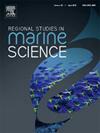Decapod community composition is seasonally driven by different environmental factors in an estuarine-coastal gradient (Eastern Brazil)
IF 2.1
4区 环境科学与生态学
Q3 ECOLOGY
引用次数: 0
Abstract
Crustacean communities are shaped by a series of ecological processes, but the degree to which different spatial and environmental dimensions affect them in surrounding estuarine-coastal gradients remains unclear. Here we analyzed decapod community data (crabs and shrimps) from the Doce River estuary and its adjacent marine coast, to test and quantify the effects that spatial and environmental factors have had on these communities three years after the Fundão mining dam failure of November 2015. We sampled communities monthly from October 2018 to September 2019 in 18 sampling sites distributed in three zones (estuary, nearshore, and offshore), resulting in 216 samples and 29 recorded taxa. Spatial eigenvector-based methods and variation partitioning approaches were used to test and quantify the pure and joint effects of spatial and environmental processes on the communities over different seasons. The spatial structures of the community composition presented differences among the four studied seasons, being driven by environmental heterogeneity as well as spatial processes unrelated to our measured variables (temperature, salinity, depth, turbidity, dissolved oxygen and pH). Specifically, the species composition and species richness responded the most to turbidity, pH, and depth during the rainy seasons, as well as salinity during the dry seasons. The variability of decapod composition surrounding the Doce River mouth is seasonally affected by a different set of environmental and spatial factors, with low intrusions of saltwater in the estuarine sector impacting the distribution of stenohaline marine species. Our results both partly uncover and emphasize the complexity resulting from environmental heterogeneity and anthropic pressures, stressing the need for further studies on local spatio-temporal dynamics of decapod fauna and other organisms to inform conservation and management actions.
求助全文
约1分钟内获得全文
求助全文
来源期刊

Regional Studies in Marine Science
Agricultural and Biological Sciences-Ecology, Evolution, Behavior and Systematics
CiteScore
3.90
自引率
4.80%
发文量
336
审稿时长
69 days
期刊介绍:
REGIONAL STUDIES IN MARINE SCIENCE will publish scientifically sound papers on regional aspects of maritime and marine resources in estuaries, coastal zones, continental shelf, the seas and oceans.
 求助内容:
求助内容: 应助结果提醒方式:
应助结果提醒方式:


